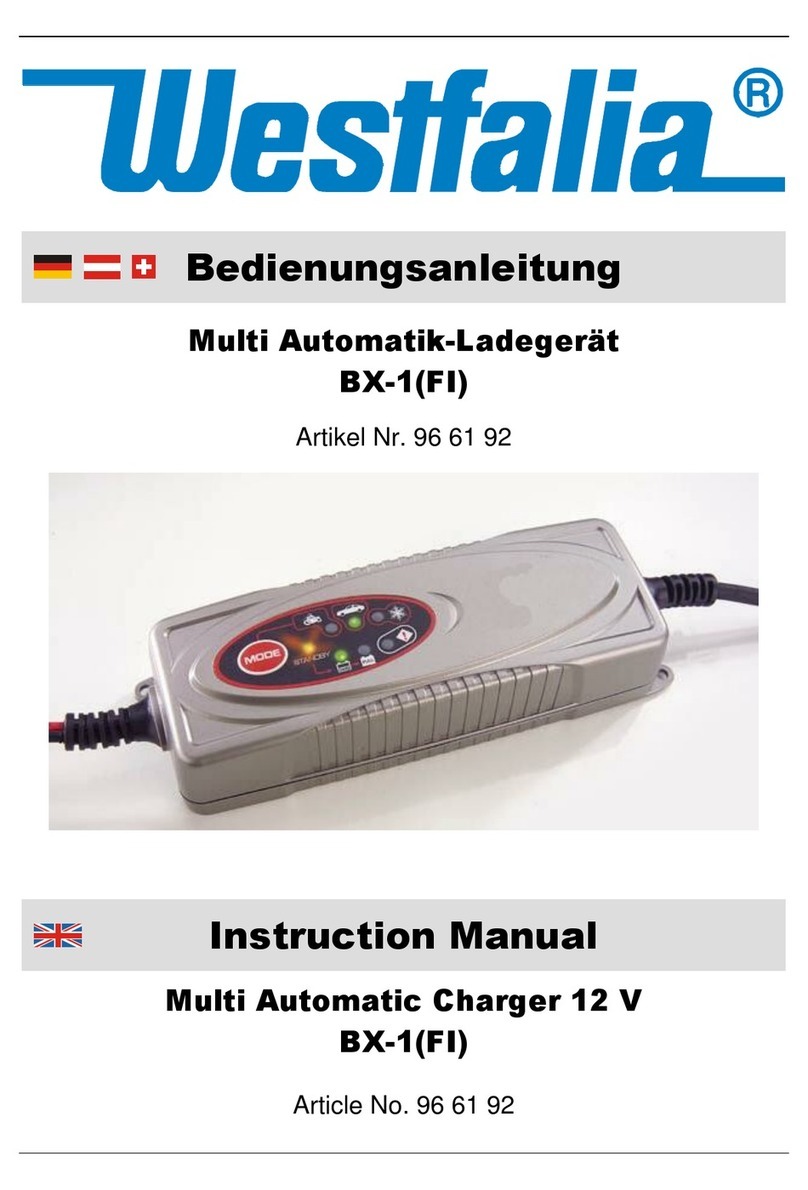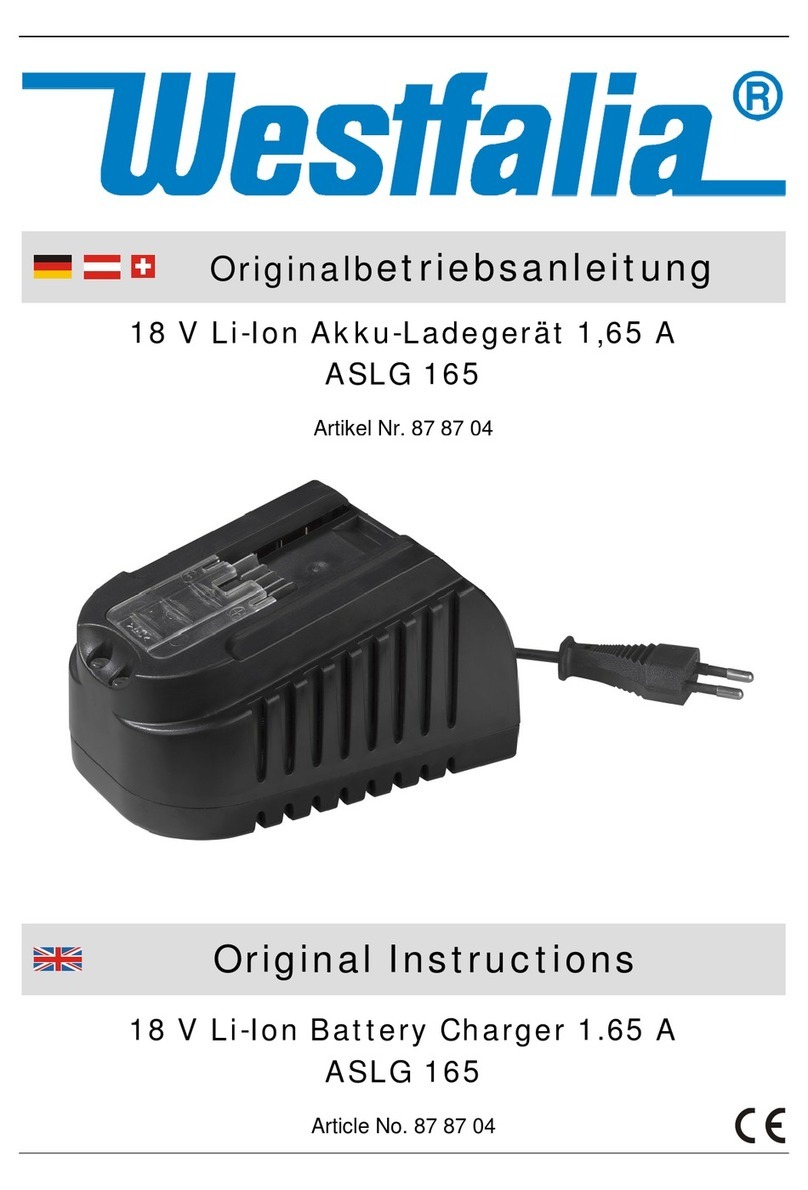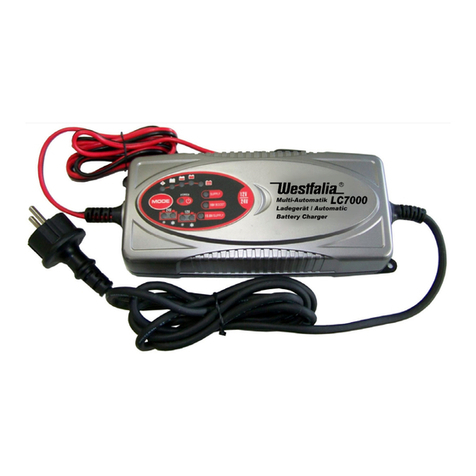Westfalia 900001506599 User manual

Owner’s Manual
Part No. 900001506599
Battery Support Unit / Battery Charger
70 Amp
Read the entire manual before using this product.
Failure to do so can result in serious injury or death.


Contents
1. Important safety instructions.............................................................. 4
2.
Personal precautions......................................................................... 5
3.
Preparing to charge ........................................................................... 6
4.
Charger location................................................................................. 7
5.
DC connection precautions................................................................ 7
6.
Follow these steps when battery is installed in vehicle. .................... 8
7.
Follow these steps when battery is outside vehicle........................... 9
8.
Battery charging – AC connections ................................................... 9
9.
Mounting instructions....................................................................... 10
10.
Control Panel ................................................................................... 11
11.
Operating instructions...................................................................... 15
12.Calculating charge time................................................................... 20
13.Maintenance instructions................................................................. 21
14.Storage instructions......................................................................... 21
15.Troubleshooting............................................................................... 22
16.Before returning for repairs.............................................................. 23
17.Limited warranty............................................................................... 23

3
IMPORTANT:
READ AND SAVE THIS SAFETY AND INSTRUCTION MANUAL.
SAVE THESE INSTRUCTIONS –The 70 Amp BSU offers a wide range of
features to accommodate your needs. This manual will show you how to use
your charger safely and effectively. Please read, understand and follow these
instructions and precautions carefully, as this manual contains important safety
and operating instructions. The safety messages used throughout this
manual contain a signal word, a message and an icon. The signal word
indicates the level of the hazard in a situation.
Indicates an imminently hazardous situation which, if not
avoided, will result in death or serious injury to the
operator or bystanders.
Indicates a potentially hazardous situation which, if
not avoided, could result in death or serious injury to
the operator or bystanders.
Indicates a potentially hazardous situation which, if
not avoided, could result in moderate or minor injury
to the operator or bystanders.
Indicates a potentially hazardous situation which, if
not avoided, could result in moderate or minor injury
to the operator or bystanders.
Safety messages in this manual contain two different type styles.
•Unnumbered type states the hazard.
•Numbered type states how to avoid the hazard.
The icon gives a graphical description of the potential hazard.

4
1.
IMPORTANT SAFETY INSTRUCTIONS
Risk of electric shock or fire.
1.1 Do not expose the charger to rain or snow.
1.2 Use only recommended attachments. Use of an attachment not
recommended or sold by Schumacher® Electric Corporation may result
in a risk of fire, electric shock or injury to persons or damage to property.
1.3 To reduce the risk of damage to the electric plug or lead, pull by the plug
rather than the lead when disconnecting the charger.
1.4 An extension lead should not be used unless absolutely necessary.
Use of an improper extension lead could result in a risk of fire and
electric shock. If an extension lead must be used, make sure:
1.4.1 That the pins on the plug of the extension lead are the same
number, size and shape as those of the plug on the charger.
1.4.2 That the extension lead is properly wired and in good electrical
condition.
1.4.3 That the wire size is large enough for the AC current rating of the
charger as specified in Section 8.2.
1.5 To reduce the risk of electric shock, unplug the charger from the outlet
before attempting any maintenance or cleaning. Simply turning off the
controls will not reduce this risk.
1.6 Remove personal metal items such as rings, bracelets, necklaces and
watches when working with a lead-acid battery. A lead-acid battery can
produce a short-circuit current high enough to weld a ring or the like to
metal, causing a severe burn.
1.7 Do not operate the charger with a damaged lead or plug; take it to a
qualified service person. (Call customer service at: +44 (0)1225 744
777.)
1.8 Do not operate the charger if it has received a sharp blow, been dropped
or otherwise damaged in any way; take it to a qualified service Person.
(Call customer service at: +44 (0)1225 744 777.)

5
1.9 Do not disassemble the charger; take it to a qualified service person
when service or repair is required. Incorrect reassembly may result in a
risk of fire or electric shock. (Call customer service at: +44 (0)1225 744
777.)
2.
PERSONAL PRECAUTIONS
Risk of explosive Gas.
2.1 Working in the vicinity of a lead acid battery is dangerous. Batteries
geneate explosive gases during normal battery operation. For this
reason, it is of utmost importance that you follow the instructions each
time you use the charger.
2.2 To reduce the risk of a battery explosion, follow these instructions and
those published by the battery manufacturer and the manufacturer of
any equipment you intend to use in the vicinity of the battery. Review the
cautionary markings on these products and on the engine.
2.3 This charger employs parts, such as switches and circuit breakers, that
tend to produce arcs and sparks. If used in a garage, locate this charger
18 inches or more above floor level.
2.4 NEVER smoke or allow a spark or flame in the vicinity of a battery or
engine.
2.5 Be extra cautious to reduce the risk of dropping a metal tool onto the
battery. It might spark or short-circuit the battery or other electrical part
that may cause an explosion.
2.6 Use this charger for charging LEAD-ACID batteries only. It is not
intended to supply power to a low voltage electrical system other than in
a starter-motor application. Do not use this battery charger for charging
dry-cell batteries that are commonly used with home appliances. These
batteries may burst and cause injury to persons and damage to property.
2.7 NEVER charge a frozen battery.
2.8 NEVER overcharge a battery.

6
3.
PREPARING TO CHARGE
Risk of contact with battery acid. Battery
acid is a highly corrosive sulphuric acid.
3.1 Consider having someone close enough by to come to your aid when you
work near a lead-acid battery.
3.2 Have plenty of fresh water and soap nearby in case battery acid contacts
your skin, clothing or eyes.
3.3 Wear complete eye and body protection, including safety goggles and
protective clothing. Avoid touching your eyes while working near the
battery.
3.4 If battery acid contacts your skin or clothing, seek suitable medical
attention immediately.
3.5 If it is necessary to remove the battery from the vehicle to charge it,
always remove the grounded terminal first. Make sure all of the
accessories in the vehicle are off to prevent arcing.
3.6 Be sure the area around the battery is well ventilated while the battery is
being charged.
3.7 Clean the battery terminals before charging the battery. During cleaning,
keep airborne corrosion from coming into contact with your eyes, nose
and mouth. Use baking soda and water to neutralize the battery acid and
help eliminate airborne corrosion. Do not touch your eyes, nose or mouth.
3.8 If applicable, add distilled water to each cell until the battery acid reaches
the level specified by the battery manufacturer. Do not overfill. For a
battery without removable cell caps, such as valve regulated lead acid
batteries (VRLA), carefully follow the manufacturer’s recharging
instructions.
3.9 Read, understand and follow all instructions for the charger, battery,
vehicle and any equipment used near the battery and charger. Study all of
the battery manufacturer’s specific precautions while charging and
recommended rates of charge.

7
3.10 Determine the voltage of the battery by referring to the vehicle owner’s
manual and make sure that the output voltage selector switch is set to the
correct voltage. If the charger has an adjustable charge rate, charge the
battery in the lowest rate first.
3.11 Make sure that the charger cable clips make tight connections.
4.
CHARGER LOCATION
Risk of explosion and contact
with battery acid.
4.1 Locate the charger as far away from the battery as the DC cables permit.
4.2 Never place the charger directly above the battery being charged; gases
from the battery will corrode and damage the charger.
4.3 Do not set the battery on top of the charger.
4.4 Never allow battery acid to drip onto the charger when reading the
electrolyte specific gravity or filling the battery.
4.5 Do not operate the charger in a closed-in area or restrict the ventilation in
any way.
5.
DC CONNECTION PRECAUTIONS
5.1 Connect and disconnect the DC output clips only after pressing the
START/STOP ( ) button to turn the output off and removing the AC
plug from the electrical outlet. Never allow the clips to touch each other.
5.2 Attach the clips to the battery and chassis, as indicated in steps 6.5, 6.6,
6.7 and 7.2 through 7.4.

8
6.
FOLLOW THESE STEPS WHEN BATTERY IS INSTALLED IN
VEHICLE.
A spark near the battery may
cause a battery explosion. To
reduce the risk of spark near the
battery:
6.1 Position the AC and DC cables to reduce the risk of damage by the
bonnet, door and moving or hot engine parts.
6.2 Stay clear of fan blades, belts, pulleys and other parts that can cause
injury.
6.3 Check the polarity of the battery posts. The POSITIVE (POS, P, +)
battery post usually has a larger diameter then the NEGATIVE (NEG, N,
-) post.
6.4 Determine which post of the battery is grounded (connected) to the
chassis. If the negative post is grounded to the chassis (as in most
vehicles), see step 6.6. If the positive post is grounded to the chassis,
see step 6.7.
6.5 If recommended by the vehicle manufacturer, disconnect the battery
supply lead from the vehicle prior to charging. You may need to also
take measures to maintain memory supply within the vehicle for some
devices/modules.
6.6 For a negative-grounded vehicle, connect the POSITIVE (RED) clip from
the battery charger to the POSITIVE (POS, P, +) ungrounded post of the
battery. Connect the NEGATIVE (BLACK) clip to the vehicle chassis or
engine block away from the battery. Do not connect the clip to the fuel
system components, fuel lines or sheet-metal body parts. Connect to a
heavy gauge metal part of the frame or engine block.
6.7 For a positive-grounded vehicle, connect the NEGATIVE (BLACK) clip
from the battery charger to the NEGATIVE (NEG, N, -) ungrounded post
of the battery. Connect the POSITIVE (RED) clip to the vehicle chassis
or engine block away from the battery. Do not connect the clip to the fuel
system components, fuel lines or sheet-metal body parts. Connect to a
heavy gauge metal part of the frame or engine block.
6.8 When disconnecting the charger press the START/STOP ( ) button
to turn the output off, disconnect the AC lead, remove the clip from the
vehicle chassis and then remove the clip from the battery terminal.
6.9 See CALCULATING CHARGE TIME for length of charge information.

9
7.
FOLLOW THESE STEPS WHEN BATTERY IS OUTSIDE VEHICLE.
A spark near the battery may
cause a battery explosion. To
reduce the risk of spark near the
battery:
7.1 Check the polarity of the battery posts. The POSITIVE (POS, P, +)
battery post usually has a larger diameter than the NEGATIVE (NEG, N,
-) post.
7.2 Attach at least a 24-inch long 4 gauge (AWG) insulated battery cable to
the NEGATIVE (NEG, N, -) battery post.
7.3 Connect the POSITIVE (RED) charger clip to the POSITIVE (POS, P, +)
post of the battery.
7.4 Position yourself and the free end of the cable you previously attached
to the NEGATIVE (NEG, N, -) battery post as far away from the battery
as possible – then connect the NEGATIVE (BLACK) charger clip to the
free end of the cable.
7.5 Do not face the battery when making the final connection.
7.6 When disconnecting the charger, press the START/STOP ( ) button
to turn the output off, disconnect the AC lead, remove the clip from the
cable attached to the negative battery terminal and then remove the clip
from the positive battery terminal.
7.7 A marine (boat) battery must be removed and charged on shore. To
charge it onboard requires equipment specially designed for marine use.
8.
BATTERY CHARGING – AC CONNECTIONS
A spark near the battery may cause a battery
explosion. To reduce the risk of spark near
the battery:
8.1 Check the polarity of the battery posts. The POSITIVE (POS, P, +)
battery post usually has a larger diameter than the NEGATIVE (NEG, N,
-) post.
8.2 Attach at least a 24-inch long 4 gauge (AWG) insulated battery cable to
the NEGATIVE (NEG, N, -) battery post.

10
8.3 Connect the POSITIVE (RED) charger clip to the POSITIVE (POS, P, +)
post of the battery.
8.4 Position yourself and the free end of the cable you previously attached
to the NEGATIVE (NEG, N, -) battery post as far away from the battery
as possible – then connect the NEGATIVE (BLACK) charger clip to the
free end of the cable.
8.5 Do not face the battery when making the final connection.
8.6 When disconnecting the charger, press the START/STOP ( ) button
to turn the output off, disconnect the AC lead, remove the clip from the
cable attached to the negative battery terminal and then remove the clip
from the positive battery terminal.
8.7 A marine (boat) battery must be removed and charged on shore. To
charge it onboard requires equipment specially designed for marine use.
9.
MOUNTING INSTRUCTIONS
This charger can be operated on a stable surface either upright or lying down
(brackets not installed). Rubber strips have been provided to help prevent
scratching and denting of the channels. If you would like to permanently mount
the charger, use the following instructions:

11
9.1 Slide all 4 brackets (Item 1) into the track on the back, from the right side,
as shown above. Make sure the set screws (Item 2) are unscrewed
enough so they do not scratch the surface of the housing.
9.2 Measure what you are mounting the charger to before deciding where to
locate the brackets (add an additional ¼ to ½ inch). Use the ruler on the
label (Item 3) to mount the brackets (Item 1) in the correct position
(position each bracket an equal distance from the center of the charger).
Note that the inches shown are for both bracket dimensions combined
(meaning the dimensions are doubled), this is for easier reference. Make
sure the ¼-28 set screws (Item 4) are unscrewed enough so the pointed
end is almost flush with the bracket. Mount the brackets (Item 1) by
tightening all 8 set screws (Item 2) to 14 in/lb (1.6 n/m) of torque.
9.3 Lift the charger by its handle and set it against your mounting location,
tighten the set screws (Item 4) to 66 in/lb (7.5 n/m) of torque to secure
the brackets (Item 1) starting with the top two brackets first
10.
CONTROL PANEL
CONNECTED (yellow) LED
The CONNECTED ( ) LED will light yellow when the battery is properly
connected.
CHARGING (yellow) LED
When charging begins, the CHARGING ( ) LED will light yellow.
CHARGED (green) LED
The CHARGED ( ) LED will light green when the charger has gone into
maintain mode.
“UP” and “DOWN” ( and ) Buttons
Use these buttons to select the amount of time or voltage depending on the
display function selected.
Start/Stop ( ) Button
This is the start and stop button for all modes.

12
Digital Display
The Digital Display gives a digital indication of voltage, current or time,
depending on the DISPLAY function chosen.
Display Button
Use this button to set the function of the digital display to one of the following:
•VOLTS (Voltmeter)
The voltmeter indicates the voltage at the battery terminals. If the
reading is less than 10.5-volts, the battery may be bad or the
connection at the charger may be poor. If the reading is 10.5 volts to
12.7 volts the battery is low – recharge it. If the reading is 12.8 volts or
more the battery is charged.
•AMPS (Ammeter)
The Ammeter indicates the amount of current, measured in amps, that
is being drawn by the battery ( 2 amps). For example, in a 20 amp
charge rate, a typical discharged battery will initially draw
approximately 20 amps. As the battery continues to charge, the
current will taper down. At full charge, the battery may draw less than
one amp.
NOTE: The 70 amp charge rate cycles between 20 amps and 70 amps
during the charging process and the ammeter will show this. This is a
normal condition.
•TIME (Timer – Range: 10 min to 120 min)
Used only in manual mode, the main function of the timer is to prevent
over charging while allowing a battery time to obtain a satisfactory
charge. To properly set the timer, you must know the size of the
battery in ampere hours or reserve capacity in minutes and the state of
charge. Often the state of charge is not known, this is one reason why
the timer was limited to 2 hours. With the aid of a battery load tester,
the state of charge can be obtained within a few seconds. For example,
the average size automotive battery at a 50% state of charge will
require 1 to 1½ hours of charging at a 40 amp rate to reach the full
charge state. For the same battery with the timer set to its maximum, 2
hours, over charging will occur, but is not likely to cause harm to a
battery that was otherwise in good condition. When the charge state is
not known, start out with a timer setting of one hour or less.

13
oHold:
This position defeats the timer function, allowing for continuous
operation. Use when you want to charge more than 2 hours.
Be sure to monitor the charging procedure and stop it when
the battery is charged. Not doing so may cause damage to
your battery or may cause other personal property damage or
personal injury
MODE Button
Use this button to select between the AUTOMATIC CHARGE, MANUAL
CHARGE and FLASH REPROGRAM function. See Operating Instructions
section for details of these functions.
Battery Type Button
Use this button to set the type of battery to be charged to STANDARD or GEL
CELL.
•Regular
Set button to STANDARD. This battery type is usually used in cars,
trucks and motorcycles. These batteries have vent caps and are often
marked “Low Maintenance” or “Maintenance-free”. This type of battery
is designed to deliver quick bursts of energy (such as starting engines)
and have a greater plate count. The plates will also be thinner and
have somewhat different material composition. Regular batteries
should not be used for deep cycle applications.
•Deep-Cycle
Set button to STANDARD. Deep-cycle batteries are usually marked as
“Deep-Cycle” or “Marine”. Deep-cycle batteries are usually larger than
the other types. This type of battery has less instant energy but
somewhat greater long-term energy delivery than regular batteries.
Deep cycle batteries have thicker plates and can survive a number of
discharge cycles.
•AGM
Set button to STANDARD. The Absorbed Glass Matt construction
allows the electrolyte to be suspended in close proximity with the
plate’s active material. In theory, this enhances both the discharge and
recharge efficiency. Actually, the AGM batteries are a variant of
Sealed VRLA (valve regulated lead acid) batteries. Popular uses
include high performance engine starting, power sports, deep cycle,
solar and storage battery. AGM batteries are typically good deep cycle
batteries and they deliver best life performance if recharged before the
battery drops below a 50 percent charge. If these AGM batteries are
completely discharged, the cycle life will be around 300 cycles. This is
true of most AGM batteries rated as deep cycle batteries.

14
•GEL
Set button to GEL CELL. The Gel Cell is similar to the AGM style
because the electrolyte is suspended, but different because technically
the AGM battery is still considered to be a wet cell. The electrolyte in a
GEL cell has a silica additive that causes it to set up or stiffen. The re-
charge voltages on this type of cell are lower than the other styles of
lead acid battery. This is probably the most sensitive cell in terms of
adverse reactions to over-voltage charging. Gel Batteries are best
used in VERY DEEP cycle application and may last a bit longer in hot
weather applications. If the incorrect battery charger is used on a Gel
Cell battery, poor performance and premature failure is certain.
The Gel Cell and the AGM batteries are specialty batteries that typically cost
twice as much as a premium wet cell. However they store very well and do not
tend to sulfate or degrade as easily as a wet cell. There is little chance of a
hydrogen gas explosion or corrosion when using these batteries; these are the
safest lead acid batteries you can use. Gel Cell and some AGM batteries may
require a special charging rate.
Charge Rate Button
Use this button to set the maximum charge rate to one of the following:
•4A Charge Rate
Intended for charging small batteries such as those commonly used in
garden tractors, snow mobiles and motorcycles.
•20A and 70A Charge Rate
Use for charging automotive and marine batteries. Not intended for
industrial applications.

15
11.
OPERATING INSTRUCTIONS
Charger Operation
NOTE: Once automatic charging or flash reprogramming has started, the
buttons will not work until you turn off the output, with the exception of the
Start/Stop ( ) button. (In MANUAL mode the “UP” and “DOWN”
( and ) buttons also still operate normally.) When the display shows OFF,
no buttons will work for five seconds as the charger automatically goes back to
the default settings.
Automatic Charging
1.
Connect the battery and AC power following the precautions listed
in sections 6, 7 and 8.
2.
Set the MODE to AUTOMATIC CHARGE.
3.
Set the BATTERY TYPE to STANDARD or GEL CELL.
4.
Set the CHARGE RATE to 4A, 20A or 70A.
5.
Press the Start/Stop ( ) button when you are ready to start
charging.
6.
The CHARGING ( ) LED will light yellow.
NOTE: Automatic charging starts only if the CONNECTED ( )
LED is lit yellow and the battery has at least a 1V charge. If the battery
is less than 1V, press and hold the Start/Stop ( ) button for five
seconds to start Auto¬matic Charging, or charge it in Manual mode for
five minutes then switch back to Automatic Charge.
7.
The CHARGED ( ) LED will light when charging is complete
and the charger has gone into maintain mode.
Manual Charging
1. Connect the battery and AC power following the precautions listed
in sections 6, 7 and 8.
2. Set the MODE to MANUAL CHARGE. (The TIME LED will start
blinking.)
3. Use “UP” and “DOWN” ( and ) buttons to set the time
(shown in minutes) you want the charger to charge the battery. Set
to to run the charger without a time limit.

16
4. Set the BATTERY TYPE to STANDARD or GEL CELL.4.
5. Set the CHARGE RATE to 4A, 20A or 70A
6. Press the Start/Stop ( ) button when you are ready to start
charging.
NOTE: Be sure to monitor the charging procedure and stop it when the
battery is charged. Not doing so may cause damage to your battery or
may cause other personal property damage or personal injury.
Charging
If the charger does not detect a properly connected battery, the
CONNECTED ( ) LED will not light until such a battery is detected.
Charging will not begin while the CONNECTED ( ) LED is not on.
When charging begins, the CHARGING ( ) LED will light yellow.
Battery Percent and Charge Time
This charger adjusts the charging time in order to charge the battery
completely, efficiently and safely. The microprocessor automatically
performs the necessary functions. This section includes guidelines that can
be used to estimate charging times.
The duration of the charging process depends on these factors:
Battery State
If a battery has only been slightly discharged, it can be charged in less than
a few hours. The same battery could take up to 10 hours if very weak. The
battery state can be estimated by using the built-in voltage tester. The lower
the reading, the longer charging will take.
Battery Rating
A higher rated battery will take longer to charge than a lower rated battery
under the same conditions. Abattery is rated in ampere hours (AH), reserve
capacity (RC) and cold cranking amps (CCA). The lower the rating, the
quicker the battery will charge.
Charge Rate
The charge rate is measured in amps. This charger provides charge rates
of 4A, 20A and 70A. The 4A rate is for charging smaller batteries such as
those used for motorcycles and garden tractors. Such batteries should not
be charged using the 20A or 70A rate. The 20A and 70A rates are for
charging larger batteries. In the 20A and 70Amode, the charger begins at a
low-charge rate and increases the charge rate if it is determined that the
battery can accept the higher rate. All charging modes will decrease the
charge current as the battery approaches maximum charge.

17
Automatic Charging Mode
When an automatic charge is performed, the charger switches to the
maintain mode automatically after the battery is charged. For a battery with
a starting voltage under 1 volt, press and hold the START/STOP ( )
button for five seconds to start Automatic Charging, or use manual mode to
pre-charge the battery for five minutes to get additional voltage into the
battery for the charger to analyse.
Aborted Charge
If charging cannot be completed normally, charging will abort. When
charging aborts, the charger’s output is shut off, the CHARGING ( )
LED will go out and the digital display will display . The charger
ignores all buttons except the START/STOP ( ) button in that state.
Press the START/STOP ( ) button to reset after an aborted charge.
Desulphation Mode
If the battery is left discharge for an extended period of time, it could
become sulfated and not accept a normal charge. If the charger detects a
sulfated battery, the charger will switch to a special mode of operation
designed for such batteries. Activation of the special desulphation mode is
indicated by the CHARGING ( ) LED blinking yellow. If successful,
normal charging will resume after the battery is desulfated. The CHARGING
( ) LED will then stop blinking and stay lit. Desulphation could take up
to 10 hours. If desulphation fails, charging will abort and the charger will go
into abort mode.
Completion of Charge
Charge completion is indicated by the CHARGED ( ) LED indicating
green. When lit, the charger has stopped charging and switched to the
Maintain Mode of operation. If you are charging a deep cycle battery, the
CHARGED ( ) LED comes on green when the battery is charged
enough for normal use.
Maintain Mode
When the CHARGED ( ) LED is lit, the charger has started Maintain
Mode. In this mode, the charger keeps the battery fully charged by
delivering a small current when necessary. The voltage is maintained at a
level determined by the BATTERYTYPE selected

18
Flash Reprogramming
NOTE: Do not attempt to Flash Reprogram a vehicle that has a discharged
or defective battery. Make sure that the vehicle battery is in good condition
and fully charged before proceeding.
1. Set MODE to FLASH REPROGRAM. (The VOLTS LED will start
blinking.)
2. Use “UP” and “DOWN” ( and ) buttons to adjust voltage to
the voltage needed for the vehicle being programmed (refer to
OEM specifications). Voltage selected is shown on the digital
display. The unit has a voltage range of 13 to 14.8, with a default
of 14.2.
NOTE: When the VOLTS LED stops blinking, the display shows
the selected voltage.
3. Press Start/Stop ( ) button to turn on the output.
4. When finished with Flash Reprogramming, press Start/Stop ( )
button to exit this mode.
Using the Battery Voltage Tester
Overview
This battery charger has a built-in voltmeter to measure your battery’s
voltage. The charger does not have a built in load tester. As such, a recently
charged battery could have a temporarily high voltage due to what is known
as “surface charge”. The voltage of such a battery will gradually drop during
the period immediately after the charging system is disengaged.
Consequently, the tester could display inconsistent values for such a battery.
For a more accurate reading, the surface charge should be removed by
temporarily creating a load on the battery, such as by turning on lights or
other accessories for a couple of minutes before you read the display. Read
it a couple of minutes after you have shut the headlights off.

19
Testing Sequence:
There are seven basic steps required to test the battery state of charge:
NOTE: The unit cannot be charging to test the battery voltage.
1. With the charger unplugged from the AC outlet, connect the
charger to the battery following the instructions given in Sections
6 and 7.
2. Plug the charger AC power lead into the AC outlet.
3. The CONNECTED ( ) LED will light yellow if a properly
connected battery is detected.
4. Confirm the CHARGING ( ) LED is off.
5. Set the DISPLAY to VOLTS
6. If the output is on, press the Start/Stop ( ) button. If the output
is already off, do not press the Start/Stop ( ) button.
7. Read the voltage on the digital display.
General Charging Notes
Fans:
The charger is designed to control its cooling fans for efficient operation.
Consequentially, it is normal for the fans to start and stop when maintaining
a fully charged battery. Keep the area near the charger clear of
obstructions to allow the fans to operate efficiently.
NOTE: The charger has thermal protection, and it will shut down if it gets
too hot.
Voltage:
The voltage displayed during charging is the charging voltage and is usually
higher than the battery’s resting voltage.
Table of contents
Other Westfalia Batteries Charger manuals
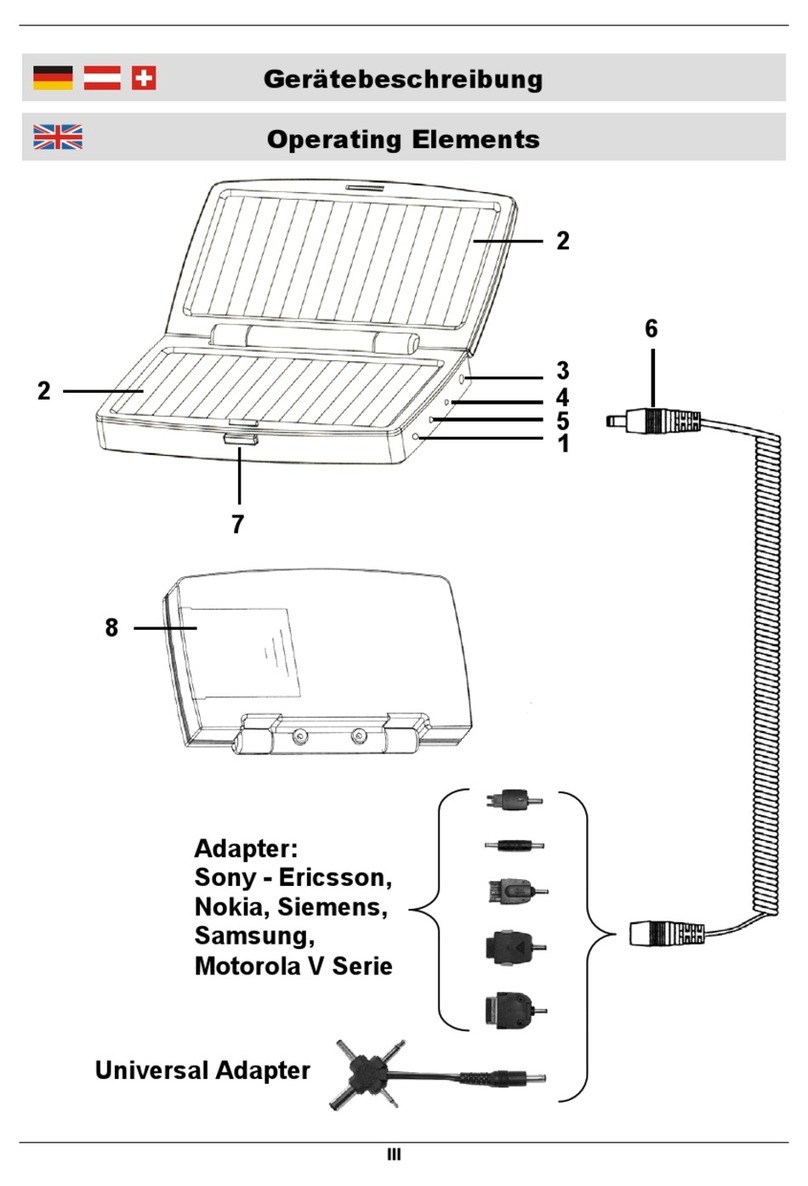
Westfalia
Westfalia TPS-916A User manual
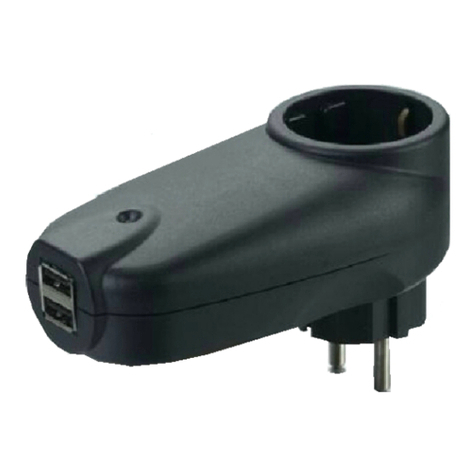
Westfalia
Westfalia GZB2U01/01 User manual

Westfalia
Westfalia ASLG User manual

Westfalia
Westfalia PIXO C2 User manual

Westfalia
Westfalia 31 49 97 User manual

Westfalia
Westfalia MW1237GT User manual
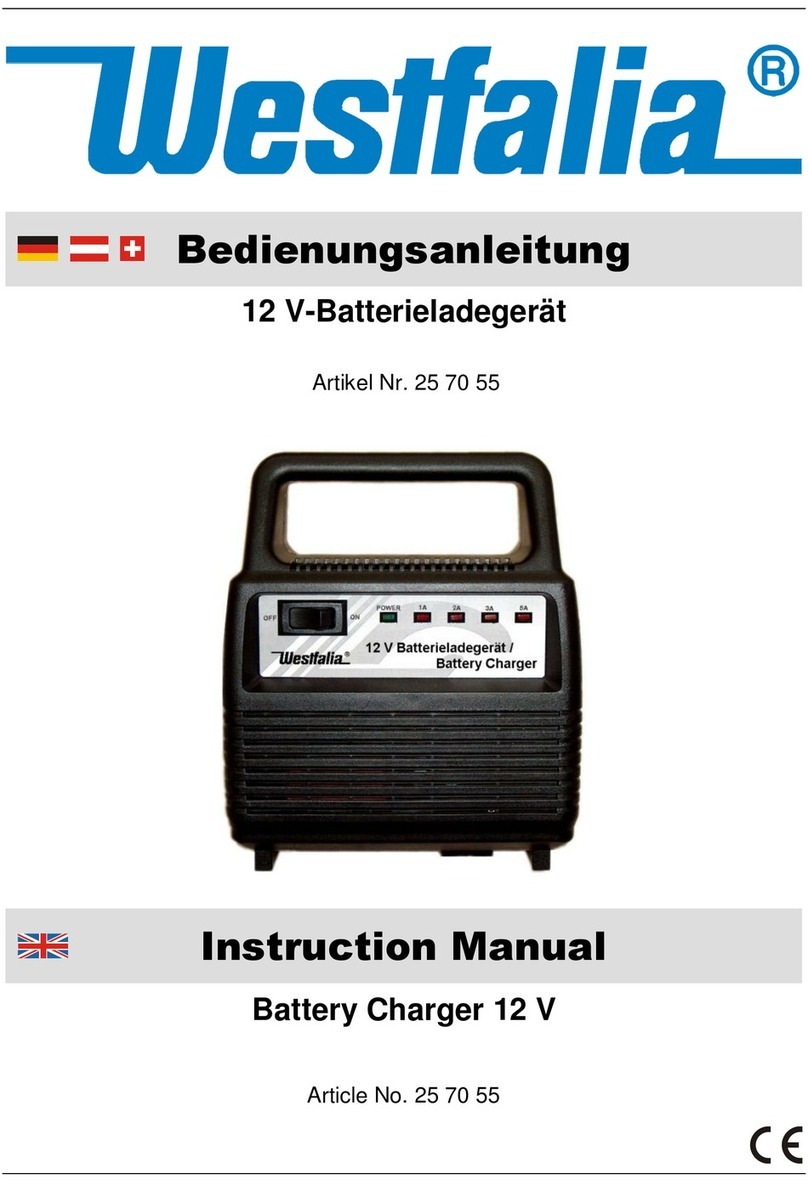
Westfalia
Westfalia 25 70 55 User manual
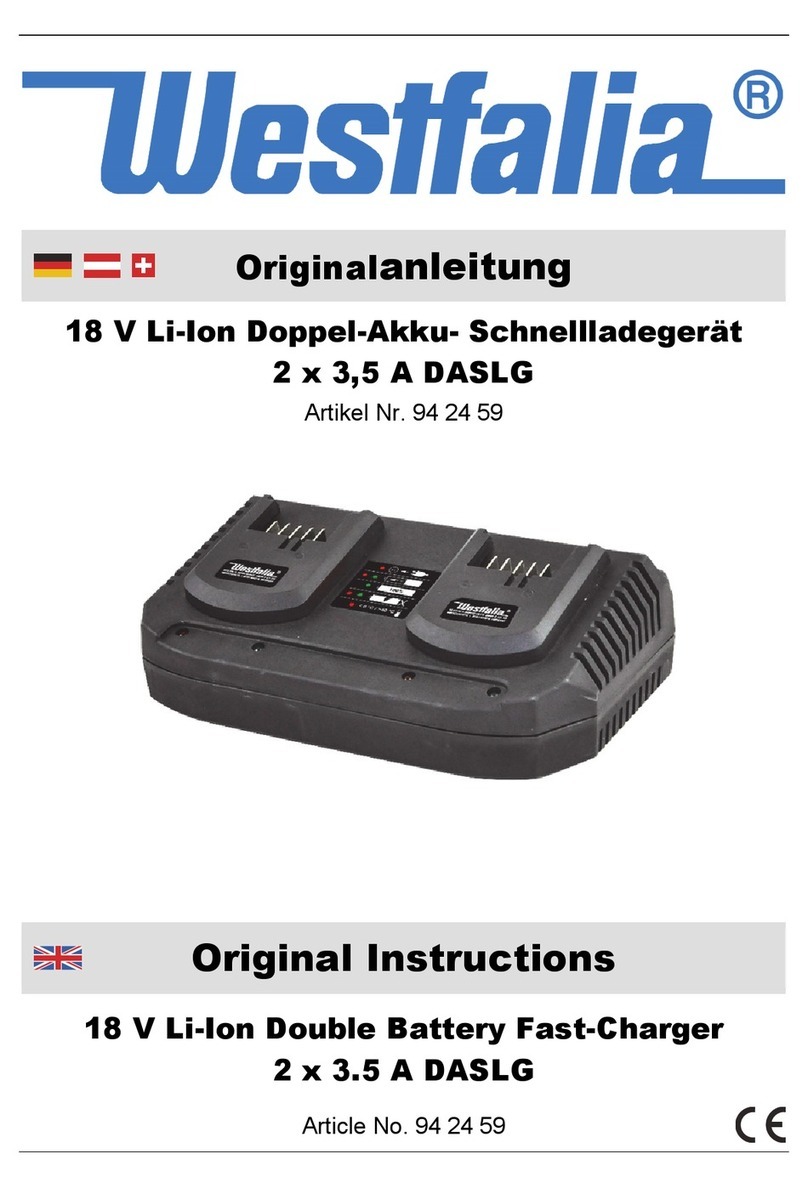
Westfalia
Westfalia 94 24 59 User manual
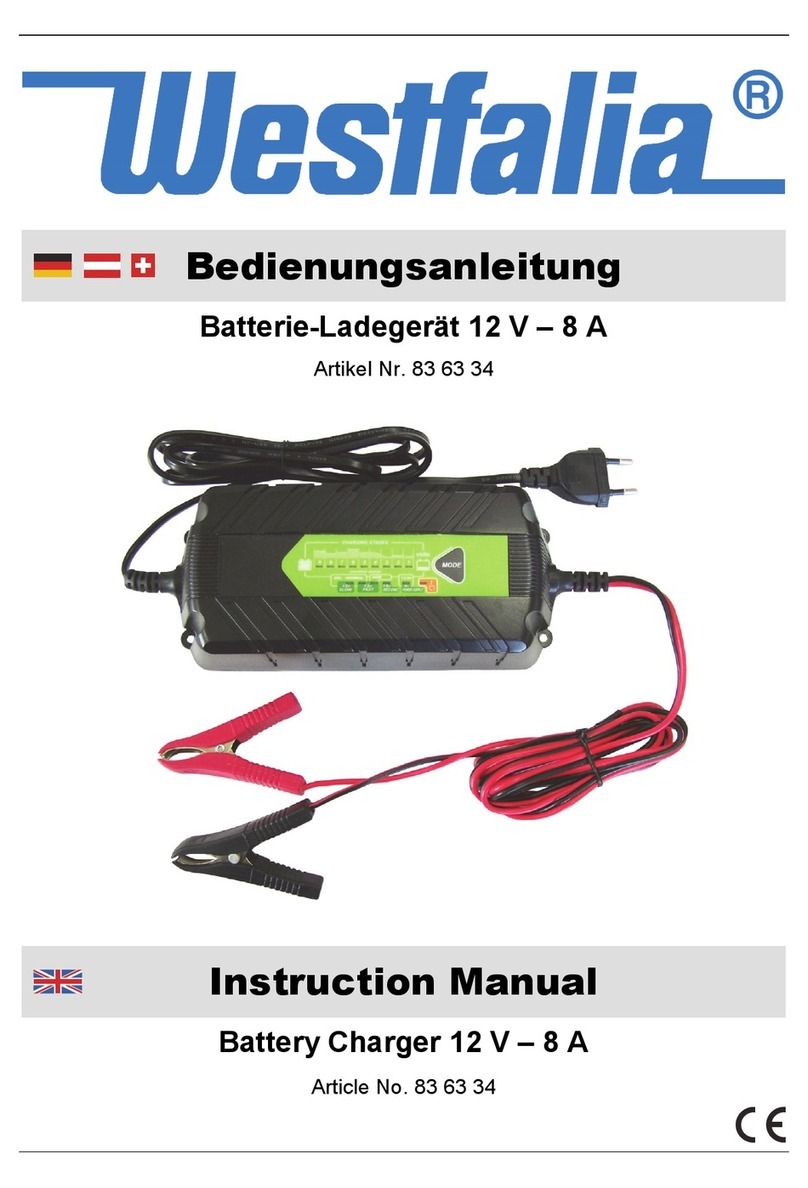
Westfalia
Westfalia 83 63 34 User manual

Westfalia
Westfalia NFQ2800 User manual

